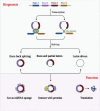Extracellular vesicles in gastric cancer: role of exosomal lncRNA and microRNA as diagnostic and therapeutic targets
- PMID: 37664422
- PMCID: PMC10469264
- DOI: 10.3389/fphys.2023.1158839
Extracellular vesicles in gastric cancer: role of exosomal lncRNA and microRNA as diagnostic and therapeutic targets
Abstract
Extracellular vesicles (EVs), including exosomes, play a crucial role in intercellular communication and have emerged as important mediators in the development and progression of gastric cancer. This review discusses the current understanding of the role of EVs, particularly exosomal lncRNA and microRNA, in gastric cancer and their potential as diagnostic and therapeutic targets. Exosomes are small membrane-bound particles secreted by both cancer cells and stromal cells within the tumor microenvironment. They contain various ncRNA and biomolecules, which can be transferred to recipient cells to promote tumor growth and metastasis. In this review, we highlighted the importance of exosomal lncRNA and microRNA in gastric cancer. Exosomal lncRNAs have been shown to regulate gene expression by interacting with transcription factors or chromatin-modifying enzymes, which regulate gene expression by binding to target mRNAs. We also discuss the potential use of exosomal lncRNAs and microRNAs as diagnostic biomarkers for gastric cancer. Exosomes can be isolated from various bodily fluids, including blood, urine, and saliva. They contain specific molecules that reflect the molecular characteristics of the tumor, making them promising candidates for non-invasive diagnostic tests. Finally, the potential of targeting exosomal lncRNAs and microRNAs as a therapeutic strategy for gastric cancer were reviewed as wee. Inhibition of specific molecules within exosomes has been shown to suppress tumor growth and metastasis in preclinical models. In conclusion, this review article provides an overview of the current understanding of the role of exosomal lncRNA and microRNA in gastric cancer. We suggest that further research into these molecules could lead to new diagnostic tools and therapeutic strategies for this deadly disease.
Keywords: biomarker; circRNAs; extracellular vesicles; gastric cancer; nanoparticles.
Copyright © 2023 Jiang, Zhang, Wang, Shan, Sun, Tan, Tong and Qiu.
Conflict of interest statement
The authors declare that the research was conducted in the absence of any commercial or financial relationships that could be construed as a potential conflict of interest.
Figures



Similar articles
-
Exosomal Long Noncoding RNAs in NSCLC: Dysfunctions and Clinical Potential.J Cancer. 2023 Jun 12;14(10):1736-1750. doi: 10.7150/jca.84506. eCollection 2023. J Cancer. 2023. PMID: 37476194 Free PMC article. Review.
-
The Potential Roles of Exosomal Non-Coding RNAs in Hepatocellular Carcinoma.Front Oncol. 2022 Feb 24;12:790916. doi: 10.3389/fonc.2022.790916. eCollection 2022. Front Oncol. 2022. PMID: 35280805 Free PMC article. Review.
-
Biological functions and clinical applications of exosomal long non-coding RNAs in cancer.J Cell Mol Med. 2020 Oct;24(20):11656-11666. doi: 10.1111/jcmm.15873. Epub 2020 Sep 14. J Cell Mol Med. 2020. PMID: 32924276 Free PMC article. Review.
-
Emerging Function and Clinical Significance of Exosomal circRNAs in Cancer.Mol Ther Nucleic Acids. 2020 Sep 4;21:367-383. doi: 10.1016/j.omtn.2020.06.008. Epub 2020 Jun 12. Mol Ther Nucleic Acids. 2020. PMID: 32650235 Free PMC article. Review.
-
[Exosomal microRNAs as a part of the cell-cell communication in cancer].Postepy Biochem. 2017;63(2):110-118. Postepy Biochem. 2017. PMID: 28689377 Review. Polish.
Cited by
-
Extracellular vesicles: Function, resilience, biomarker, bioengineering, and clinical implications.Tzu Chi Med J. 2024 May 24;36(3):251-259. doi: 10.4103/tcmj.tcmj_28_24. eCollection 2024 Jul-Sep. Tzu Chi Med J. 2024. PMID: 38993825 Free PMC article. Review.
-
LncRNAs in serum-derived extracellular vesicles are potential biomarker and correlated with immune infiltration in gastric cancer.Front Immunol. 2025 Jan 24;16:1533111. doi: 10.3389/fimmu.2025.1533111. eCollection 2025. Front Immunol. 2025. PMID: 39925803 Free PMC article.
-
Exosomal miR-502-5p suppresses the progression of gastric cancer by repressing angiogenesis through the Wnt/β-catenin pathway.Ir J Med Sci. 2024 Dec;193(6):2681-2694. doi: 10.1007/s11845-024-03789-0. Epub 2024 Sep 26. Ir J Med Sci. 2024. PMID: 39325329
-
The Importance of Extracellular Vesicle Screening in Gastric Cancer: A 2024 Update.Cancers (Basel). 2024 Jul 18;16(14):2574. doi: 10.3390/cancers16142574. Cancers (Basel). 2024. PMID: 39061213 Free PMC article. Review.
-
Bibliometric and visualized analysis of global research on microRNAs in gastric cancer: from 2013 to 2023.Front Oncol. 2024 May 10;14:1374743. doi: 10.3389/fonc.2024.1374743. eCollection 2024. Front Oncol. 2024. PMID: 38800413 Free PMC article. Review.
References
-
- Ansari M. A., Thiruvengadam M., Venkidasamy B., Alomary M. N., Salawi A., Chung I. M., et al. (2022). Exosome-based nanomedicine for cancer treatment by targeting inflammatory pathways: current status and future perspectives. Semin. Cancer Biol. 86, 678–696. 10.1016/j.semcancer.2022.04.005 - DOI - PubMed
Publication types
LinkOut - more resources
Full Text Sources

